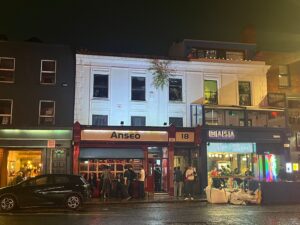 On our perambulations around Dublin this week, we visit what feels like a proper dive bar…that is, assuming proper dive bars all have a few good local taps and a killer playlist. If so, then Anseo is, indeed, in that category. But its slightly-scrubby-yet-cheerful interior doesn’t entirely hide the building’s history: this is a mid-18th century house, complete with a few extant interior features, that’s been repurposed as a pub since the mid-19th century. If you know where to look, you can spot some of that legacy hiding in plain sight.
On our perambulations around Dublin this week, we visit what feels like a proper dive bar…that is, assuming proper dive bars all have a few good local taps and a killer playlist. If so, then Anseo is, indeed, in that category. But its slightly-scrubby-yet-cheerful interior doesn’t entirely hide the building’s history: this is a mid-18th century house, complete with a few extant interior features, that’s been repurposed as a pub since the mid-19th century. If you know where to look, you can spot some of that legacy hiding in plain sight.
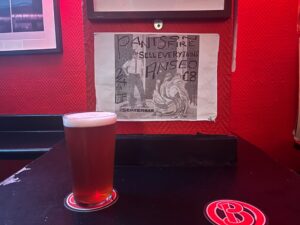 You are most likely to be visiting Anseo to catch a gig from an up-and-coming band or artist, or, perhaps, seeing some stand-up comedy upstairs; you may also be doing a Camden Street pub crawl before a show elsewhere along the way, or as a standalone activity. But regardless of what’s brought you here, the dark red walls and fairy lights make for quite a pleasant spot for a Scraggy Bay or an Ambush (or, perhaps, Beamish, if you prefer), and while the music isn’t especially quiet, it’s well-chosen. There are books and café tables along the wall opposite the bar, and while at first glance it may not feel like an ‘Irish pub’ to the visitor, on closer inspection, it’s hard to find it anything but.
You are most likely to be visiting Anseo to catch a gig from an up-and-coming band or artist, or, perhaps, seeing some stand-up comedy upstairs; you may also be doing a Camden Street pub crawl before a show elsewhere along the way, or as a standalone activity. But regardless of what’s brought you here, the dark red walls and fairy lights make for quite a pleasant spot for a Scraggy Bay or an Ambush (or, perhaps, Beamish, if you prefer), and while the music isn’t especially quiet, it’s well-chosen. There are books and café tables along the wall opposite the bar, and while at first glance it may not feel like an ‘Irish pub’ to the visitor, on closer inspection, it’s hard to find it anything but.

First, of course, the name: ‘Anseo‘ is Irish for ‘here,’ and a quick scan of the posters all over the pub for bands and comedians turns of plenty of local colour, in both the Irish and English languages. The books, too, have a good mix of hyperlocal as well as global political and literary interest, and, again, there is good support for local Irish independent beer. The tea, naturally, is Barry’s. In short, despite some universal dive bar superficialities, this bar is as ‘Irish’ as they come.
You won’t find the glass-and-dark-wood snugs and plush seats of an Old Man Pub here, but you will find locals and visitors of all (adult) ages, enjoying what feels like a real community spot. In short, it’s a perfect spot for a pre-gig pint, whether that show is just up the stairs or a quick hop down the road.
Where: 18 Camden Street Lower
Access from the city centre: Buses 9, 14, 15, 16, 27, 56A, 65B, 77A, 83, 140, 151, 15-ish minute walk
Food: N/A
Sport: Occasional rugby
TVs: A few screens here and there
Music: Bands, DJs, comedy
Family-friendliness: Not for the kids
Pub-crawl-ability: High – The Bleeding Horse, Devitt’s, Teach Tábhairne Ag Teach, The Camden, The Portobello Bar, Whelan’s, Ryan’s of Camden Street…and the local ‘Spoon’s, Keavan’s Port
Local sites of note: Iveagh Gardens, St Stephen’s Green, National Concert Hall, St Kevin’s Park, Grand Canal
Haunted: Maybe! There’s plenty of ‘atmosphere’
Other notes: Main-floor toilets
Socials: Instagram
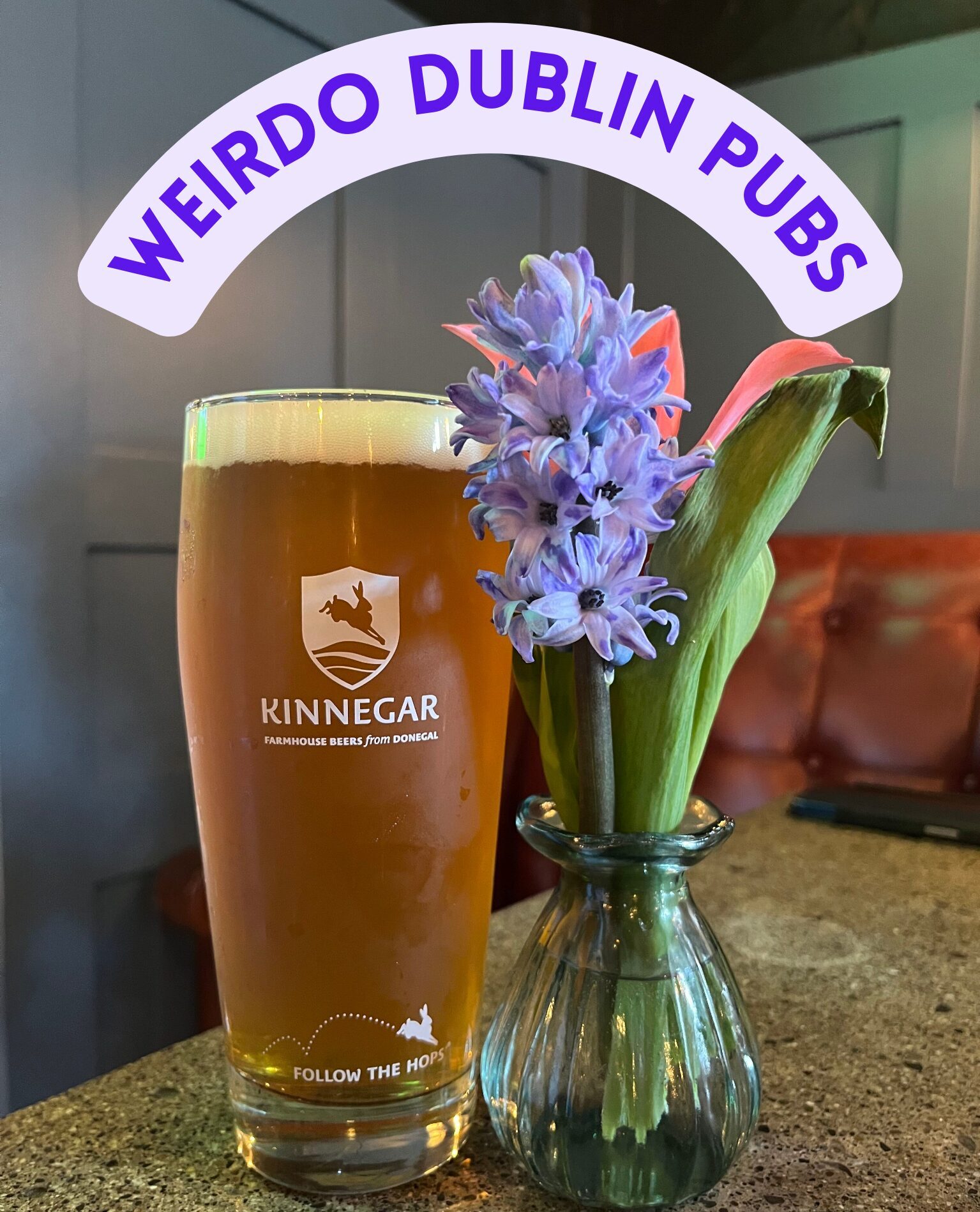
 As regular readers know, we are always on the lookout for
As regular readers know, we are always on the lookout for  While the ‘since 1793’ date is a little shaky, given the current building’s construction
While the ‘since 1793’ date is a little shaky, given the current building’s construction  So, ghosts aside, what is the pub like? Well…most definitely not creepy. If anything, it’s a bit too polished to feel at all like a liminal space. There are several very different sections of the pub with their own character, but none are especially dark or gloomy. The front is much more ‘pubby’ and the rear more of a restaurant or hotel bar vibe (the many large TV screens are part of what gives that impression), though it’s worth knowing that the back bar is where the sole local-craft-beer representative is; there’s a Rye River tap if you know where to look. Indeed, the food was very good – a step up from a lot of pub food, though the enormous portions are perhaps created more for tourists than locals. There’s also the usual Guinness – and Murphy’s – plus some Warsteiner.
So, ghosts aside, what is the pub like? Well…most definitely not creepy. If anything, it’s a bit too polished to feel at all like a liminal space. There are several very different sections of the pub with their own character, but none are especially dark or gloomy. The front is much more ‘pubby’ and the rear more of a restaurant or hotel bar vibe (the many large TV screens are part of what gives that impression), though it’s worth knowing that the back bar is where the sole local-craft-beer representative is; there’s a Rye River tap if you know where to look. Indeed, the food was very good – a step up from a lot of pub food, though the enormous portions are perhaps created more for tourists than locals. There’s also the usual Guinness – and Murphy’s – plus some Warsteiner. There’s a covered outdoor space too, more
There’s a covered outdoor space too, more 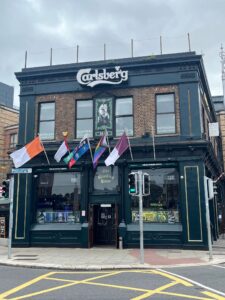
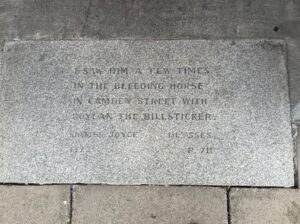 The Bleeding Horse gets the usual James Joyce namecheck in Ulysses, complete with a stone at the door to remind the visitor, but I’m personally more interested in the
The Bleeding Horse gets the usual James Joyce namecheck in Ulysses, complete with a stone at the door to remind the visitor, but I’m personally more interested in the 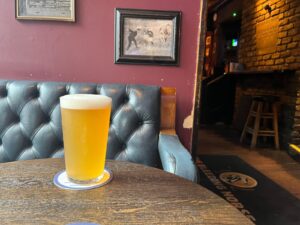 A 17th century ale-house would have been somewhat akin to our modern ‘wet pub’ (yes, it’s a terrible phrase), with drink on offer, but little else, while an inn would have offered accommodation as well as refreshment. And although ‘public houses’
A 17th century ale-house would have been somewhat akin to our modern ‘wet pub’ (yes, it’s a terrible phrase), with drink on offer, but little else, while an inn would have offered accommodation as well as refreshment. And although ‘public houses’ 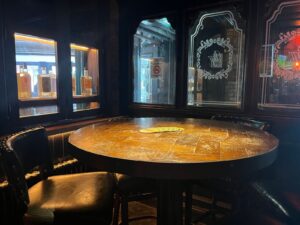
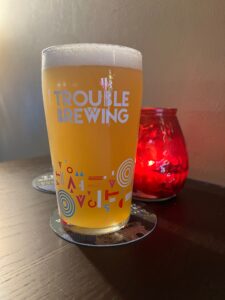
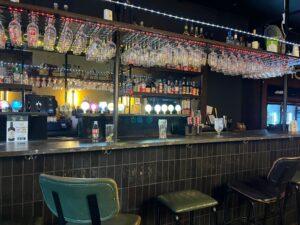 Now rebranded Teach Tábhairne Ag Teacht (so, ‘pub’ or ‘pub coming,’ perhaps? My Irish is all second-hand, based on my smaller child’s school assignments), the changes are less cosmetic and more fundamental to the feel of the place. In its former guise, the pub had been renovated under two years ago, and it considerably brightening things up, giving it a bit of glamour, while still feeling quite ‘pubby.’ Now, though, it just feels dark, as if some of the still-newish improvements have been scuffed or sullied up a bit. The real problem, however, is what’s happened to the beer. While obviously no longer a Galway Bay pub, it’s gone from having an always-interesting selection of house and guest beers to a tiny handful of craft taps. On the plus side, the Ambush was in good shape, but I need to be in the mood for The White Hag’s Púca – a fruited sour, for the uninitiated – and only one other (rotating?) tap, at the moment from Galway Hooker. For our purposes here, I’m not counting the Beavertown Neck Oil as any kind of upgrade to the lineup, the rest of which is all
Now rebranded Teach Tábhairne Ag Teacht (so, ‘pub’ or ‘pub coming,’ perhaps? My Irish is all second-hand, based on my smaller child’s school assignments), the changes are less cosmetic and more fundamental to the feel of the place. In its former guise, the pub had been renovated under two years ago, and it considerably brightening things up, giving it a bit of glamour, while still feeling quite ‘pubby.’ Now, though, it just feels dark, as if some of the still-newish improvements have been scuffed or sullied up a bit. The real problem, however, is what’s happened to the beer. While obviously no longer a Galway Bay pub, it’s gone from having an always-interesting selection of house and guest beers to a tiny handful of craft taps. On the plus side, the Ambush was in good shape, but I need to be in the mood for The White Hag’s Púca – a fruited sour, for the uninitiated – and only one other (rotating?) tap, at the moment from Galway Hooker. For our purposes here, I’m not counting the Beavertown Neck Oil as any kind of upgrade to the lineup, the rest of which is all 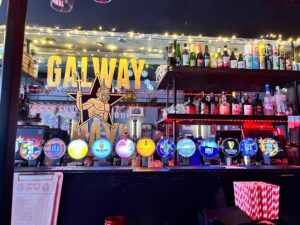 Well, that wasn’t the only reason, though it was a bit too on brand for that…but I digress.
Well, that wasn’t the only reason, though it was a bit too on brand for that…but I digress.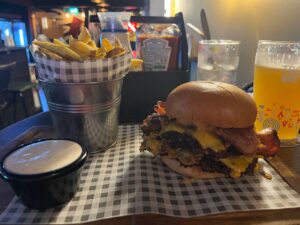 While not (as far as I am aware) directly related to Galway Bay Brewing, there is a short-term-but-still around nod toward Galway and a ‘temporary’ rebranding as Gaillimh Abú (essentially, ‘up Galway!’) for the All-Ireland football and camogie finals (including discounts for Galway supporters in their jerseys – a few jerseys on the wall being the main evidence of this inside), but as someone who lives near Croke Park and sees all the GAA fans stream past my house on their way into the stadium*, trekking to and from this part of town before a game can be a non-trivial task. Without getting into the nuances of which pubs are ‘homes’ to which county supporters – a much bigger topic – it’s fair to say a lot of the pre-gaming happens closer to the action – I tend to simply avoid my local pubs on game days because of the crowds.
While not (as far as I am aware) directly related to Galway Bay Brewing, there is a short-term-but-still around nod toward Galway and a ‘temporary’ rebranding as Gaillimh Abú (essentially, ‘up Galway!’) for the All-Ireland football and camogie finals (including discounts for Galway supporters in their jerseys – a few jerseys on the wall being the main evidence of this inside), but as someone who lives near Croke Park and sees all the GAA fans stream past my house on their way into the stadium*, trekking to and from this part of town before a game can be a non-trivial task. Without getting into the nuances of which pubs are ‘homes’ to which county supporters – a much bigger topic – it’s fair to say a lot of the pre-gaming happens closer to the action – I tend to simply avoid my local pubs on game days because of the crowds.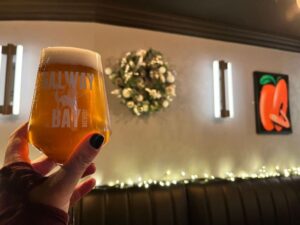 Crowds, though, were noticeably absent on my visit to Teach Tábhairne, while other spots on the same street had a lively presence. On one hand, it gave more opportunity to chat to the wonderful staff. On the other, however, this is no longer a pub to settle in to try a variety of different things. It’s more of a spot to get a quick bit to eat and a glass or a pint on the way somewhere else, instead of a destination in its own right.
Crowds, though, were noticeably absent on my visit to Teach Tábhairne, while other spots on the same street had a lively presence. On one hand, it gave more opportunity to chat to the wonderful staff. On the other, however, this is no longer a pub to settle in to try a variety of different things. It’s more of a spot to get a quick bit to eat and a glass or a pint on the way somewhere else, instead of a destination in its own right.